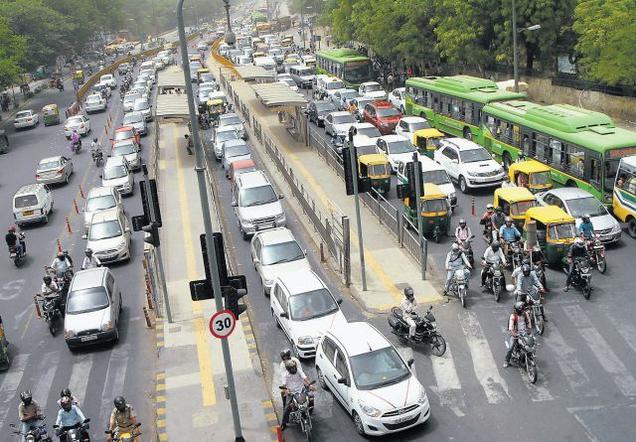 Even as the fate of the Ambedkar Nagar-Moolchand BRT corridor hangs in balance, the operators of the corridor, the Delhi Integrated Multi-Modal Transit Systems (DIMTS), have submitted proposals to the Delhi Transport Department to decongest the corridor.
Even as the fate of the Ambedkar Nagar-Moolchand BRT corridor hangs in balance, the operators of the corridor, the Delhi Integrated Multi-Modal Transit Systems (DIMTS), have submitted proposals to the Delhi Transport Department to decongest the corridor.
The proposed plan, in the immediate term, is primarily aimed at decongesting the Chirag Dilli intersection – the biggest traffic bottleneck on the 5.8-km-long corridor.
The plan includes providing an additional traffic signal before the said intersection near the Chirag Dilli village and utilising two unused roads in the vicinity – one near Masjid Moth village and the other running parallel to the drain near Chirag Dilli nursery – for diverting traffic from the intersection.
Officials said the proposed interventions, which have been done after an analysis of the traffic volume on all major roads at and around the intersections, would decrease the signal cycles and almost double the dispersal of traffic at the Chirag Dilli intersection.
“The queue of vehicles heading from Press Enclave to Nehru Place is stretched up to 450 metres during the peak hour. We plan to install an additional traffic signal around 250 metres before the Chirag Dilli intersection. Near the proposed signal lies an unused road near Masjid Moth. It could be converted into a four-lane road. Vehicles moving from Press Enclave to Nehru Place could be diverted from the signal, which would decrease the burden on the main intersection,” said a DIMTS official.
Officials said the same road could be used for diverting the traffic coming from Moolchand and headed towards IIT. “Instead of taking a right turn, the vehicles would be able to use the Masjid Moth road to get on to the Chirag Dilli flyover,” he added.
The officials said a road parallel to a drain near the nursery could be used for channelising the traffic from Nehru Place to Moolchand without taking a right turn at the Chirag Dilli intersection. The DIMTS officials have also suggested some other long-term measures to decongest the intersection by constructing an underpass and elevated corridors. However, the officials said traffic dispersal at the intersection would increase manifold even if the short-term plan is implemented.
While the DIMTS officials have given a presentation of the new plan before Delhi Transport Minister Saurabh Bhardwaj and the Transport Commissioner over the last few days, the plan might be sent to the UTTIPEC for evaluation.
The only BRT corridor in the city has been under the scanner for massive traffic jams ever since it became operational. It became a major poll issue ahead of the 2013 Assembly elections. Despite defending the BRT corridor in the Delhi High Court and managing to have a ruling in its favour, the Sheila Dikshit Government had decided to scrap the corridor in the last leg of the election campaign.
Removal of the BRT was one of the major poll issues in the Greater Kailash Assembly constituency, which is currently represented by Transport Minister Saurabh Bhardwaj. The Aam Admi Party had included scrapping of the BRT as one of the key elements of its local manifesto for the constituency.
